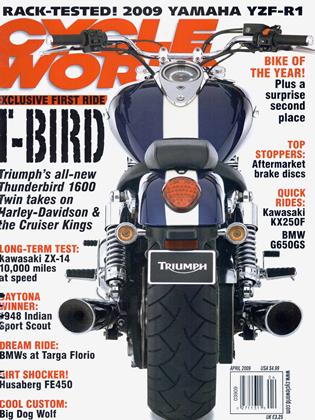Tool Time
The doctor is in! Or at least it looks like he is in when the stethoscope from Graham Tools (part #52750, $25; www.grahamtool.com) is dangling around your neck. Many decades ago, savvy mechanics began using medical stethoscopes to detect the source of noises in cars and motorcycles. That was before a few tool companies started selling scopes designed for that specific purpose. For the most part, this one from Graham is typical of the breed in that it involves a long metal probe that not only transmits mechanical sounds but also is fitted with a small in-line diaphragm that magnifies them. This scope also includes a funnel-shaped amplifier on a long, hollow tube that lets you track down noises caused by air, vacuum and exhaust leaks.
When troubleshooting non-mechanical noises, you perform your Doctor of Motors act by first aiming the funnel in the general vicinity of the sound and moving it around until the volume begins to get louder. You then keep tracking that sound, following the increases in
its volume until you find the source.
For mechanical noises, you touch the end of the metal probe to the general area of the bike that you suspect is near the source and, as with the funnel, keep moving it, touching other nearby parts until the sound starts getting louder. As you move closer to its source, the problematic noise becomes more distinctive and recognizable, making it easier to determine which components are most likely its cause.
Graham is not the only purveyor of diagnostic stethoscopes; many auto parts stores and tool suppliers also sell them, sometimes even at a lower price. But the quality of this one is a bit higher than usual, and most others include neither the rubber funnel nor its long extension tube that can access hard-to-reach areas.
Man not only has his vices, he also has his vises, which brings me to another useful item from Graham Tools: the Vise Soft Jaws (part #001; $20). These polyurethane inserts slip over the steel jaws of a bench vise and are secured by two rare-earth magnets embedded in each piece. The Jaws are soft enough that you can clamp delicate or easily scratched parts (plastic or painted pieces, polished or chromed engine covers, etc.) in the vise without the risk of damaging them, yet they are hard enough to hold less-fragile items firmly in place.
As with the stethoscope, Graham Tools is not an exclusive marketer of soft vise jaws. But I like these because they are wider than usual (most others I’ve used are 4 inches wide) and can easily be cut with a hacksaw to fit narrower vises.
What’s more, their serrated faces do a better job of holding delicate parts in place with only light clamping force, and their rare-earth magnets secure them to the vise more firmly than do the weaker magnets on other soft jaws I have used.
 View Full Issue
View Full Issue
More From This Issue
-
 Up Front
Up FrontBike of the Year
April 2009 By David Edwards -
 Leanings
LeaningsThe Captive Enfield
April 2009 By Peter Egan -
 TDC
TDCBreakage
April 2009 By Kevin Cameron -
 Departments
DepartmentsHotshots
April 2009 -
 Roundup
RoundupCall of the Wild
April 2009 By Mark Hoyer -
 Roundup
RoundupCustoms Live: Reports of Hot-Rodding's Demise Have Been Greatly Exaggerated
April 2009 By Paul Dean

